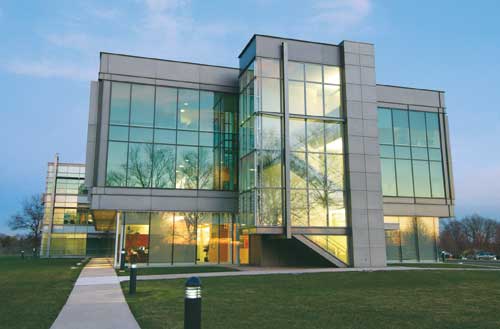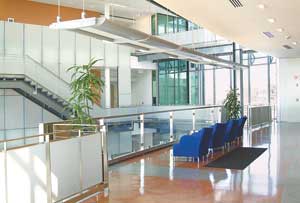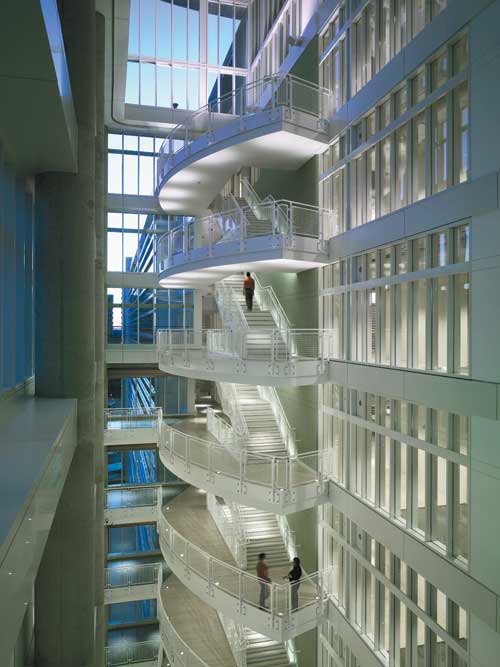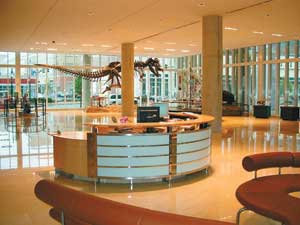LEED for Existing Buildings
The History of LEED-EB
The pilot version of LEED-EB launched in January 2002, and version 2.0, which made mostly minor changes to clarify the requirements, launched in October 2004. By the end of 2005, however, the system was still seeing only limited use, especially relative to LEED-NC. A host of factors likely contributed to this lackluster performance. The most obvious is that "with existing buildings, there's no dedicated funding mechanism for greening like there is for new buildings," says Gatlin. "The building manager isn't looking for ways to spend more money." Another challenge, according to Arny, is that "there isn't one external driver, like the architect. There are cleaning companies, people who maintain the mechanical system, people who replace the light bulbs, and people who do site management."
Other factors in the slow progress of LEED-EB were easier to remedy, though, and in 2006 USGBC began to address them through a major overhaul of the rating system. The new version, entitled LEED-EB Operations & Maintenance (LEED-EB O&M), launched in January 2008. The most significant change was reducing overlap with LEED-NC, by removing a prerequisite related to erosion on construction sites, for example, and by reducing the number of points available for daylighting and views.
 |
Armstrong, a manufacturer of floors, cabinets, and ceilings, achieved LEED-EB Platinum status in 2007 for a building at their headquarters in Lancaster, Pennsylvania. Photo courtesy Armstrong World Industries |
Â
USGBC's LEED-EB team also worked to make the rating system less intimidating and more intuitive. Strategies included streamlining the documentation requirements and reducing the number of prerequisites, notably dropping one requiring commissioning. "There has always been a lot of misunderstanding about the costs and benefits of commissioning," says Gatlin. "There's such a severe misperception that it could have made it impossible for LEED-EB to achieve significant market uptake." So USGBC replaced that prerequisite with one for an energy audit and building systems management plan and added six optional points for commissioning.
 |
Armstrong recycles 60 percent of its waste, halved its water and electricity usage, garners 75 percent of its energy through wind power, and employs acoustic ceilings and sound-absorbing surfaces throughout the building. Photo courtesy Armstrong World Industries |
The team also increased the value of strategies related to water and energy. They boosted the number of points for water efficiency from 5 out of 85 points to 10 out of 92 points. "We're finding that water needs to get a lot of points because of climate change," says Gatlin, "not just from a water-scarcity perspective but because of the energy embodied in its treatment and pumping." They also increased the number of energy-related points from 23 to 30 and strengthened the energy-performance prerequisite so that all certified buildings must achieve an Energy Star score of 69 or higher. (A draft of LEED-EB O&M 2009, which was going out for member ballot at press time, includes changes to the point allocations but only minimal changes to the credit requirements.)
While some parts of the rating system have become more challenging and others have become easier, observers tend to agree that, overall, the new version has maintained a similar level of rigor. Most also consider O&M a substantial improvement because of its better organization and increased user-friendliness. Due to a combination of rising energy costs, growing environmental awareness, increasing familiarity with LEED-EB, and approval of the latest version, the reluctance of existing-building owners to get involved in LEED seems to be melting. According to Gatlin, about 2,000 projects have registered for LEED-EB, including more than 700 just since the launch of O&M.
Getting Started
Many project owners begin the journey toward LEED-EB certification by hiring a consultant familiar with the requirements and with experience working with USGBC. Jim Baker, director of facilities at Armstrong World Industries, says that hiring Re:Vision Architecture "was our best move," as he worked to certify Armstrong's corporate headquarters in Lancaster, Pennsylvania. "Our staff did most of the work," he says, "but Re:Vision managed the process, kept us on deadline, and did all of the paperwork." Re:Vision's Bill Craig says his firm's primary role was editing Armstrong's policies and establishing relationships with consultants and service providers, including a wind-power provider, a green-cleaning provider, and a commissioning authority.
 |
The Discovery Communications headquarters in Maryland was one of the first commercial buildings to receive a LEED-EB O&M Platinum certification. Photo © Richard Mendelkorn |
Â
Certification requires more than just a good consultant, however. "It's really important that the key people on the owner's side take this stuff to heart," says Craig, adding that "it's easier on everyone if there's a team rather than a single person who acts as a funnel point." CTG's Hammond says it's important to involve several people, including, at a minimum, "the purchasing manager, the waste hauler, the green cleaning manager, and the facilities wrench-turners, as well as the facilities manager."
 |
The changes made by Discovery were mostly operational, including buying carbon offsets and renewable energy certificates, as well as challenging employees to participate in recycling programs. Photo © Prakash Patel |
Once the team is assembled, the next step is a "gap analysis," or an assessment of the building's current practices relative to the LEED-EB requirements. "We looked at all of the LEED points and broke them into categories: green, yellow, and red," says Larry Laque, executive vice president of facilities at Discovery Communications, which earned a Platinum rating for its Silver Spring, Maryland, headquarters in December 2007. The team working on Colorado's State Capitol Building, the first building to earn certification through LEED-EB O&M, went through a similar exercise; according to energy manager Richard Lee, "the focus then became to move as many of the ‘maybe' points as we could into the ‘yes' category."
"Which credits are easy and hard depends on the building," says Arny. A few credit areas routinely surface as relatively simple, however. USGBC's Gatlin considers waste recycling, green cleaning, and environmentally responsible purchasing to be "the glide path to high-performance buildings." Most project teams also focus on water and energy-which Gatlin calls "the classics"-because many improvements in these areas eventually pay for themselves in reduced operating costs. "It's not like new marble for the lobby," he says.









